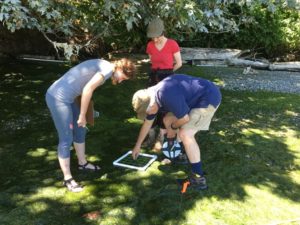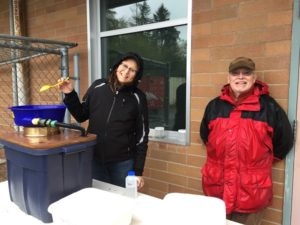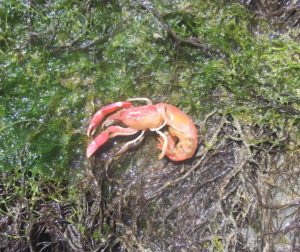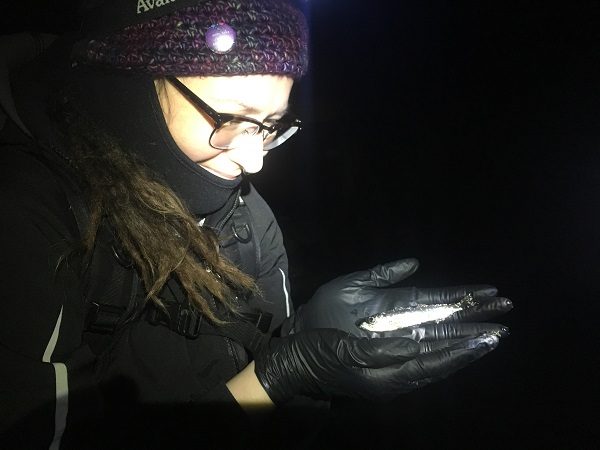
Logging more than 50 VNC volunteer hours this year, Stephen Fogard (in blue shirt) has gained enough experience that he now helps train new BeachNET volunteers in data collection protocols.
Recent news of ailing orcas is stirring a sense of urgency around the health of our favorite whales and underscores their reliance on thriving salmon populations, which depend on the smaller and aptly named forage fish, like surf smelt and sand lance. For the past three years, volunteers with Vashon Nature Center’s BeachNET (Beach Nearshore Ecology Team) have visited island shores to collect data on characteristics related to forage fish and salmon health. These ecosystem “check-ups” provide important feedback to land managers about the effects of shoreline armoring (bulkheads) on salmon health, and contribute to a regional database being developed to help scientists and resource managers better gauge the health of the entire Salish Sea.
“It’s significant that we have this depth of baseline ‘before’ data because a lot of monitoring happens only after restoration,” says Vashon Nature Center education specialist Maria Metler, who manages the forage fish research volunteers. “After witnessing these sites for three years we have a solid understanding of their makeup before restoration, and that’s going to make the post-restoration ‘after’ data all the more meaningful now that the bulkheads have been removed.”
So far this year, the BeachNET forage fish team has logged more than 387 volunteer hours. In addition to 16 individual volunteers, the project received a boost from 65 Vashon High School (VHS) and AP environmental science students, and the generous assistance of five Vashon-Maury Land Trust summer interns.
This strong volunteer force known for quality data collection has prompted Washington Department of Natural Resources managers to use BeachNET as a model to develop similar programs at seven other aquatic reserves around the Salish Sea.
Local action for salmon health

“It’s easy to say that you ‘love the Sound’ but it’s something else entirely to contribute to real science that is affecting real change for the health and ecology of such an incredible place,” says volunteer Kat Herold-Daniels pictured, left, with Steve Fogard, about her BeachNET experience.
“We have an extremely well-supported program and our actively engaged volunteers are crucial to its success,” Metler, says. “Our volunteers are at the forefront of helping to broaden the conversation around protecting salmon and orcas, showing there is a lot more we can do in our own front yards beyond stream restoration. Shoreline restoration has been a critical missing piece and our group is helping spread the word.”
In the past, restoration has focused mainly on restoring spawning habitat in rivers and streams, but now researchers are bringing to light the importance of juvenile salmon habitat—how young fish disperse along the shoreline and what they need to survive.
Kat Herold-Daniels, a BeachNET volunteer and student in Fish and Wildlife Conservation at Oregon State University, says her hands-on science experience with Vashon Nature Center has enriched her contributions to online classes.
“One of the many awesome things I have learned is how bulkheads impact shoreline ecology and how such an interruption in the conversation between the beach and the uplands dramatically impacts the sand spawning forage fish that juvenile salmon rely on to get big and strong for the long voyage out to the open ocean,” says Herold-Daniels, who has logged more than 40 hours with BeachNET this year. “An extension of that is the situation facing our southern resident killer whales and their connection to dwindling Puget Sound Chinook salmon populations. Once you see the association between bulkheads and starving whales you can’t ‘unsee’ it—and understanding a problem is the first step to fixing it.”
BeachNET volunteer Stephen Fogard and Herold-Daniels are in a friendly competition for clocking the most hours on the beach.

Beyond the fun of collecting data with a group of curious people, each BeachNET survey brings new discoveries, including this juvenile octopus and, rarely seen on beaches, a Puget Sound ghost shrimp (below).
“I love to get outside and to be involved with nature,” says Fogard, a retired postal carrier who has given more than 50 hours to VNC research projects in 2018. “With climate change, there is a need for all of us to engage in actions that are part of the solution. Citizen science is fun—it gets me out  of the house and doing stuff with my neighbors.”
of the house and doing stuff with my neighbors.”
Community science stars
Metler uses the term “community science” because of the unifying nature of this work that she sees build connections among islanders from a variety of backgrounds—from high school students and professionals, to grandparents and PhDs—all working together to improve the health of our home waters.
BeachNET also offers VHS students a chance to explore science beyond the lab—for many this is the first time they’ve used a standardized protocol in the field. Land Trust interns, whose work included planting and expanding buffers to improve island stream health, learned about the broader picture of salmon health while collecting data at the beach.
“I want to thank our volunteers for their dedication and commitment to get out there even when it’s dark, cold, hot, or windy—and for always having such fantastic questions that make it about so much more than collecting data,” Metler says. “I hope they feel a sense of pride that this program will be modeled throughout the Salish Sea.”
Join us for a night out at the beach: BeachNET low-tide night surveys begin this month and offer a rare opportunity to explore island shorelines after dark with expert naturalists. We welcome new volunteers and require only a three-hour commitment per survey. To get hands-on science experience and learn more about island beaches and wildlife, contact Maria Metler. (Photos by Maria Metler.)

